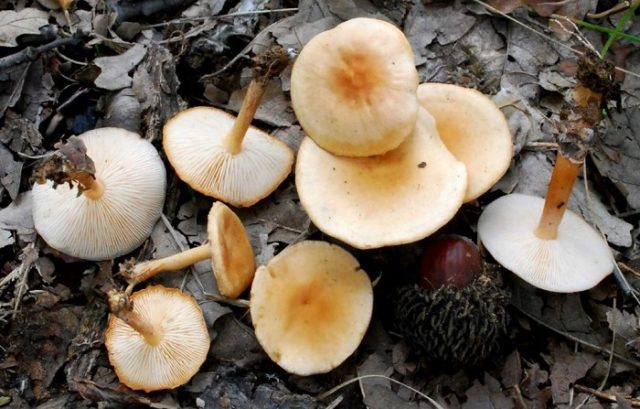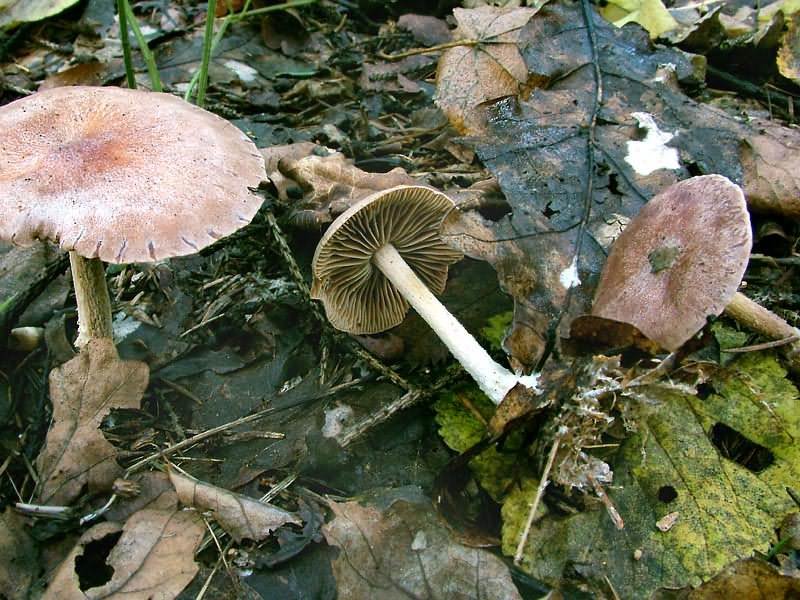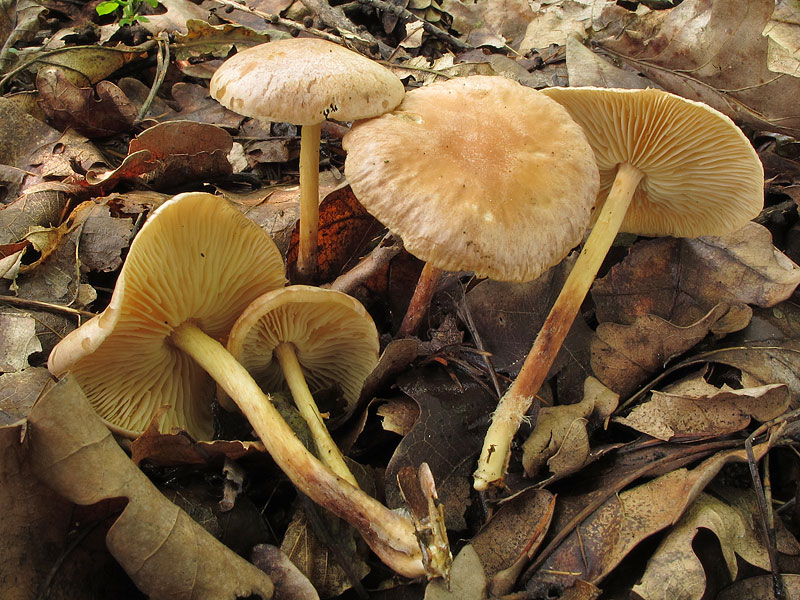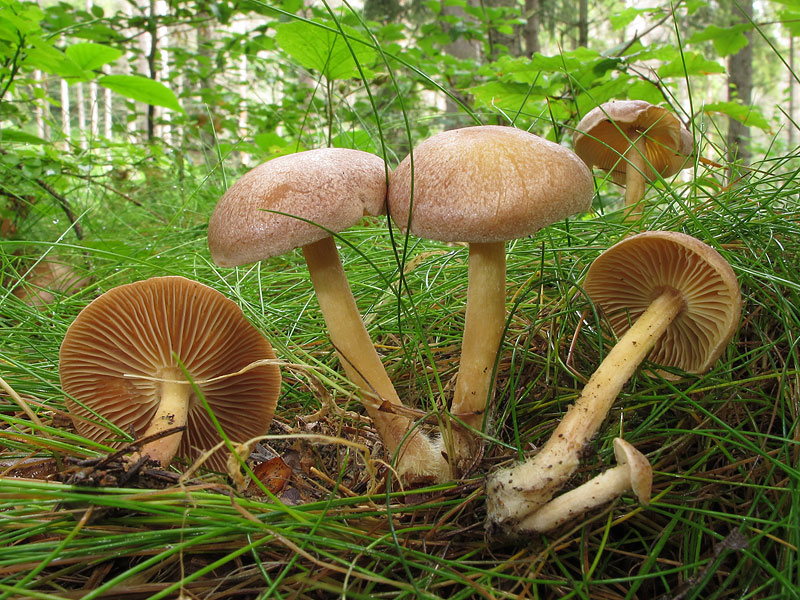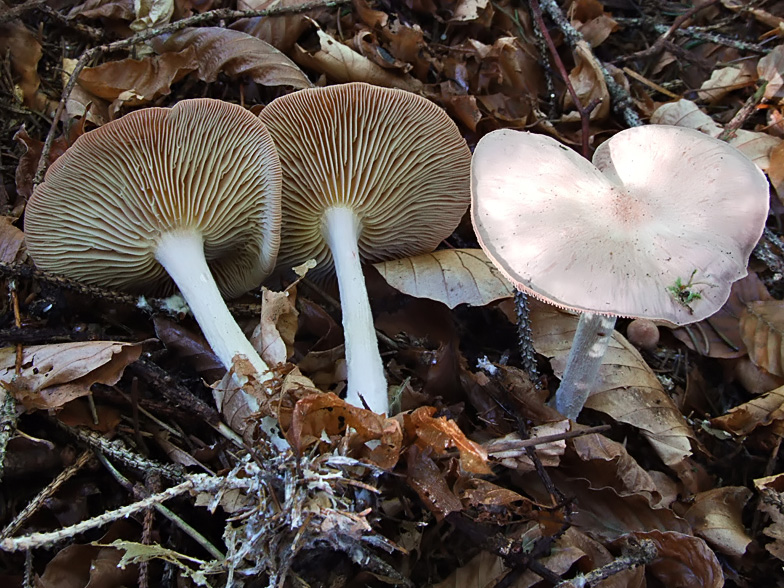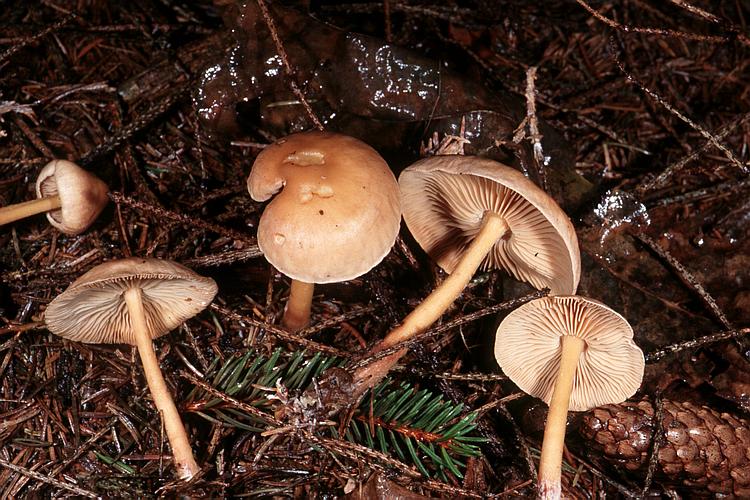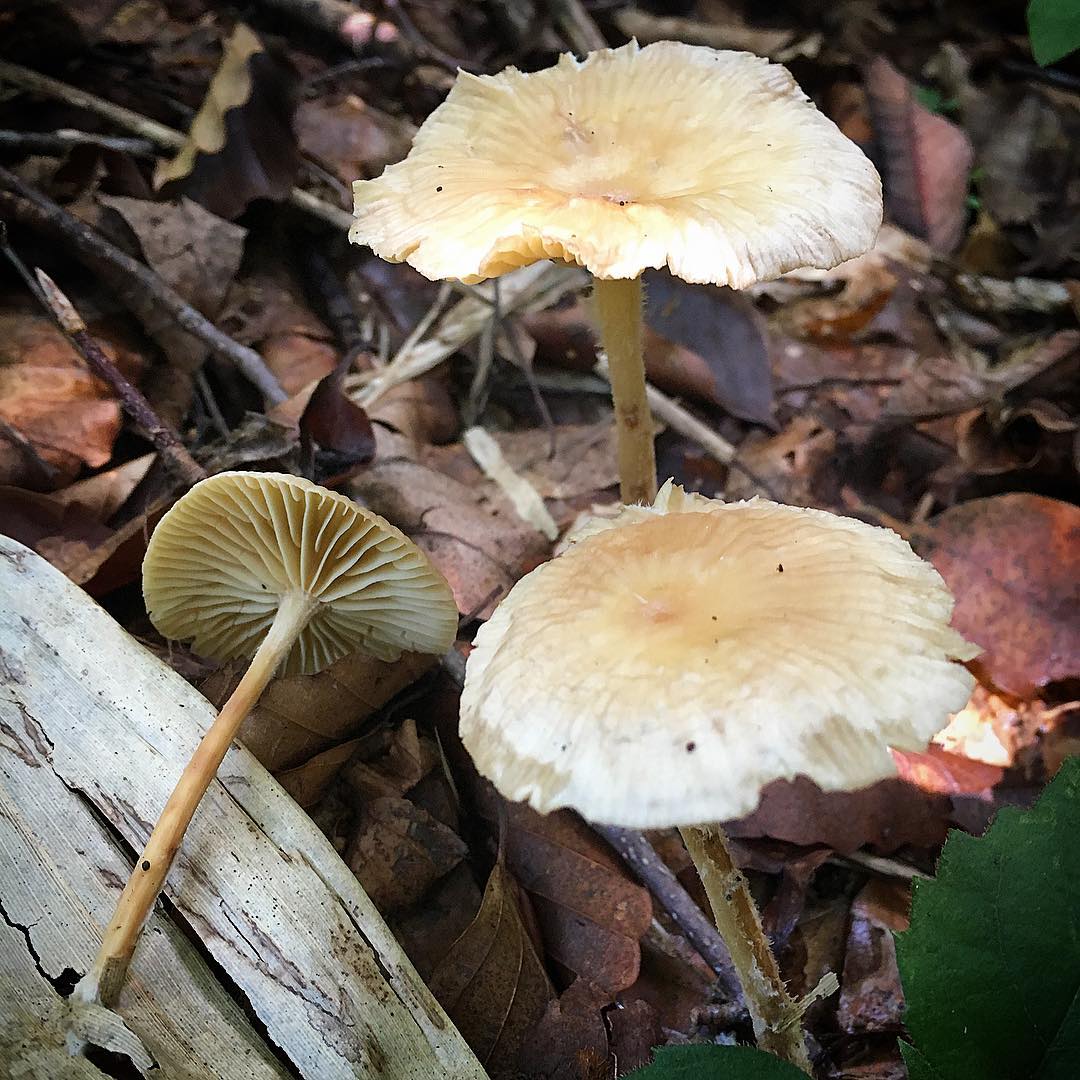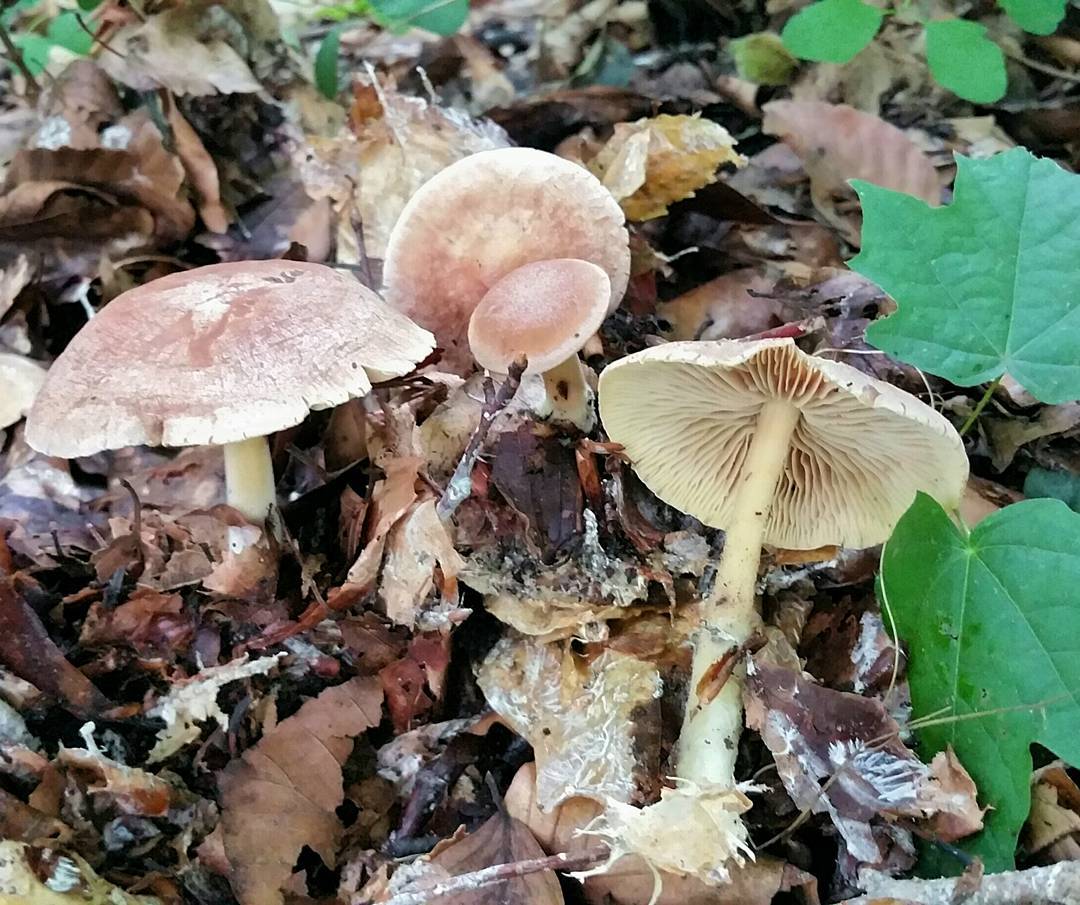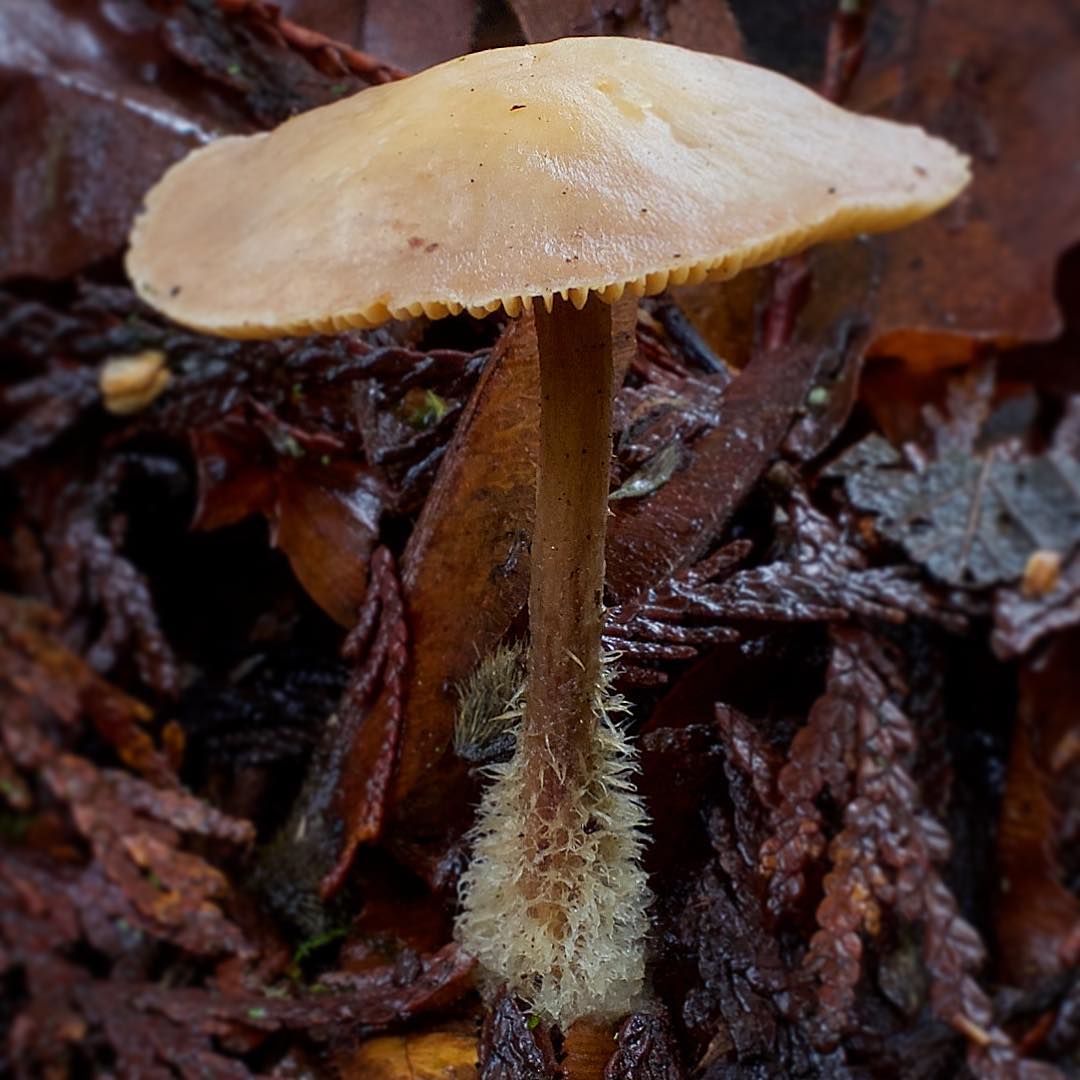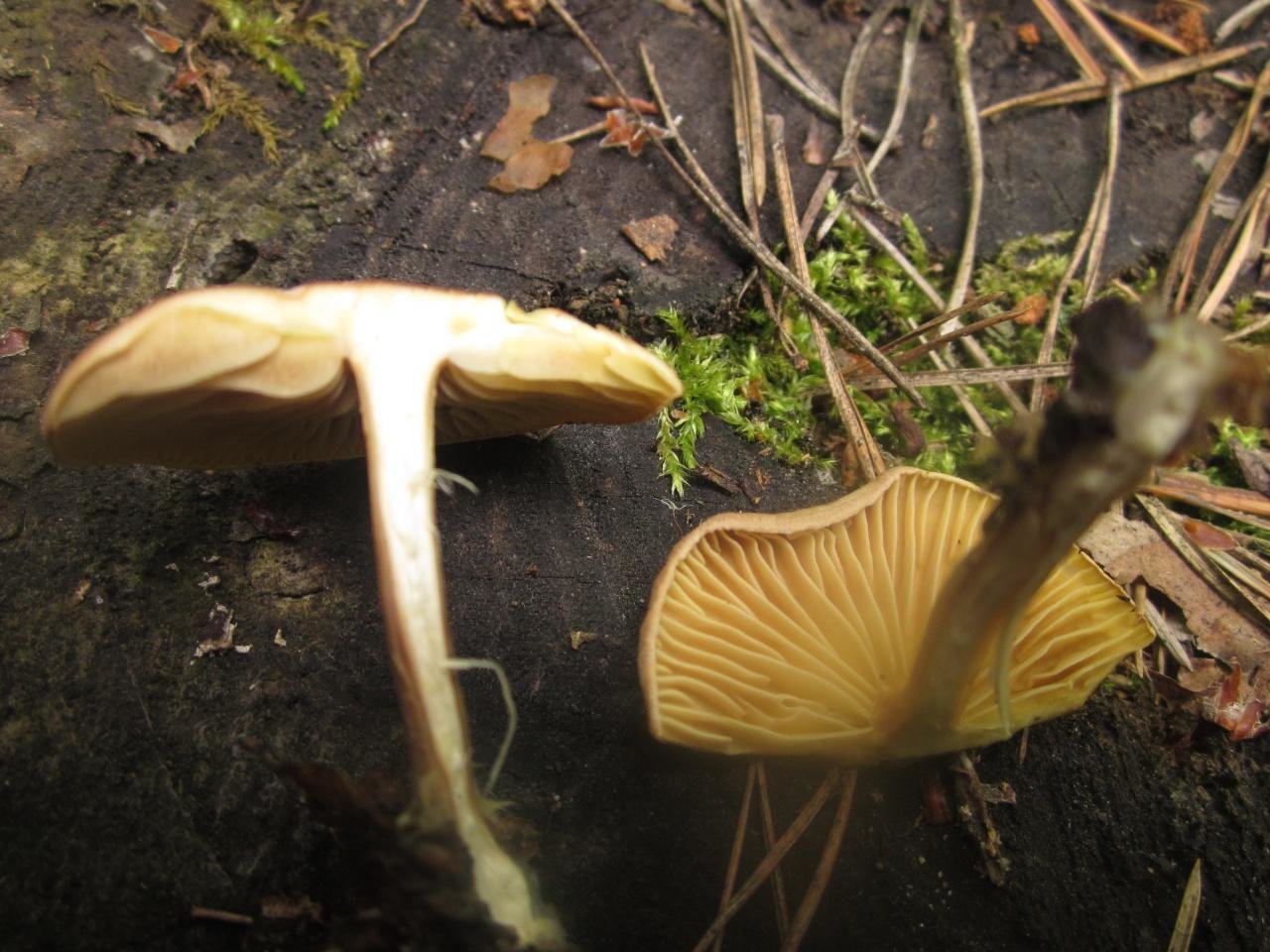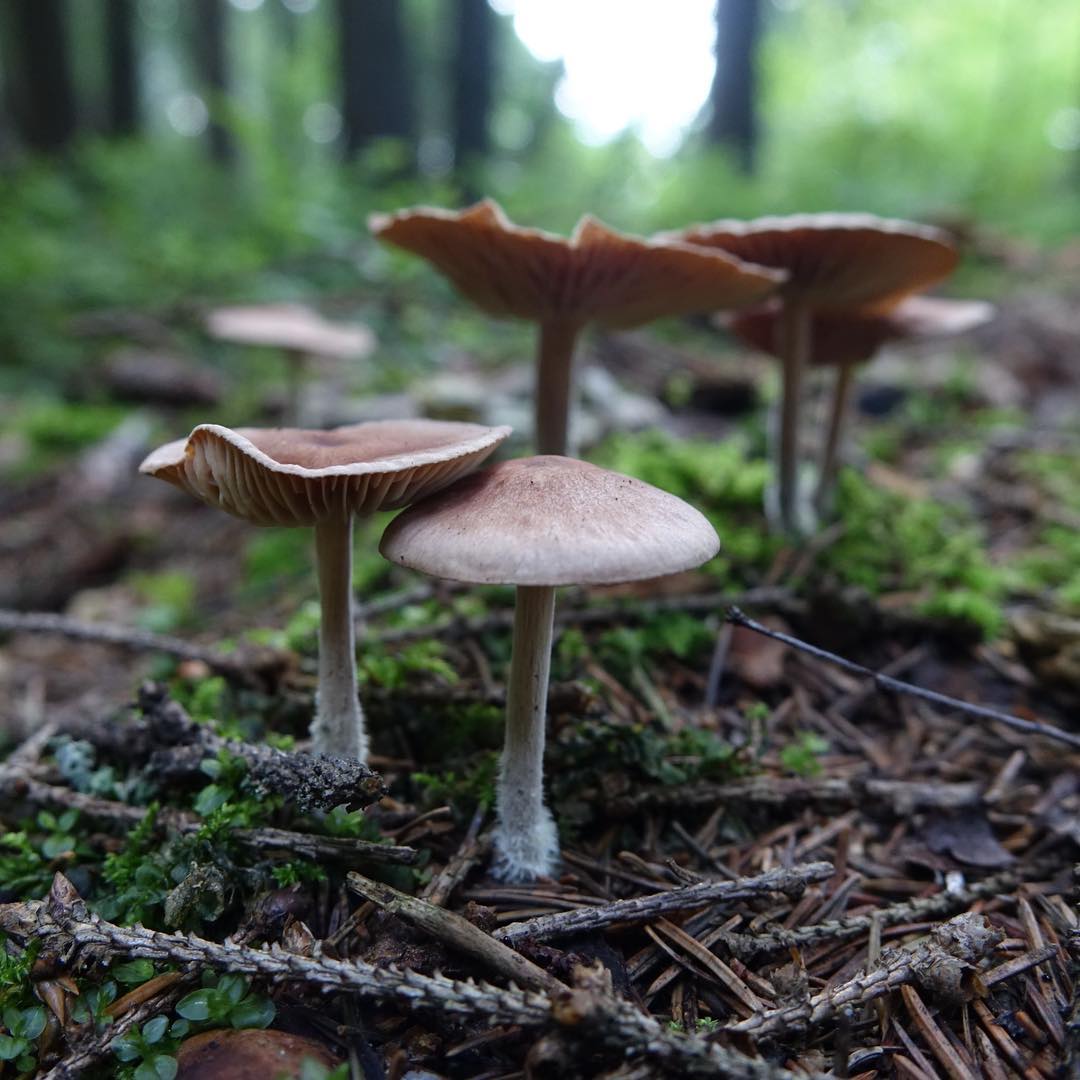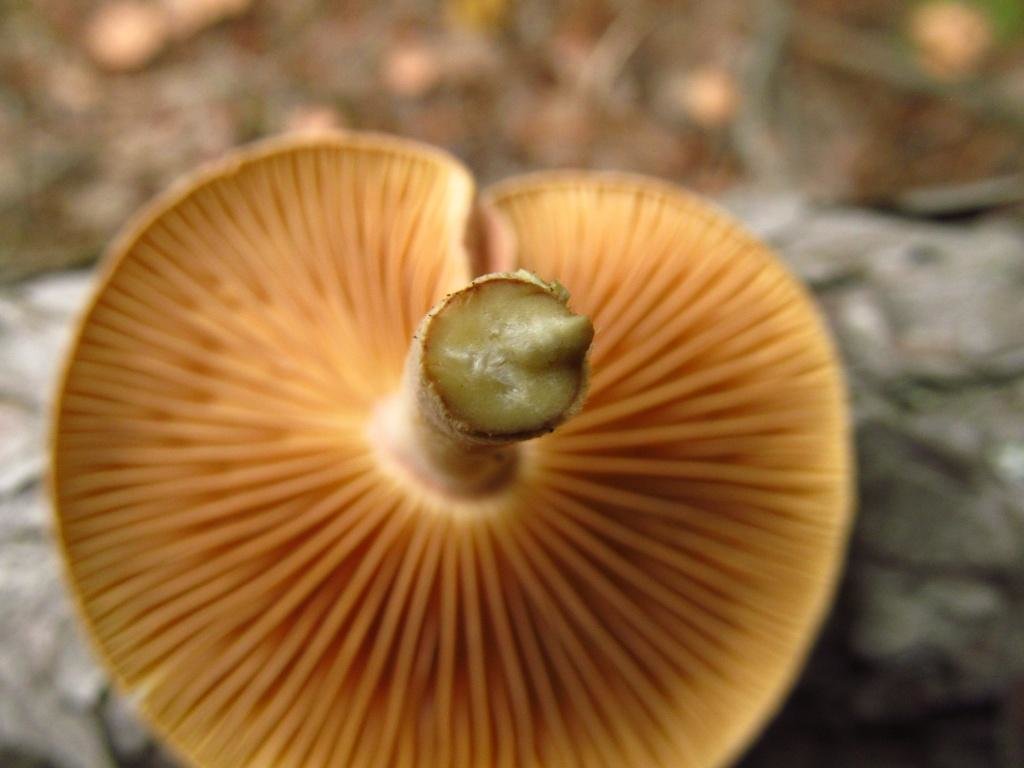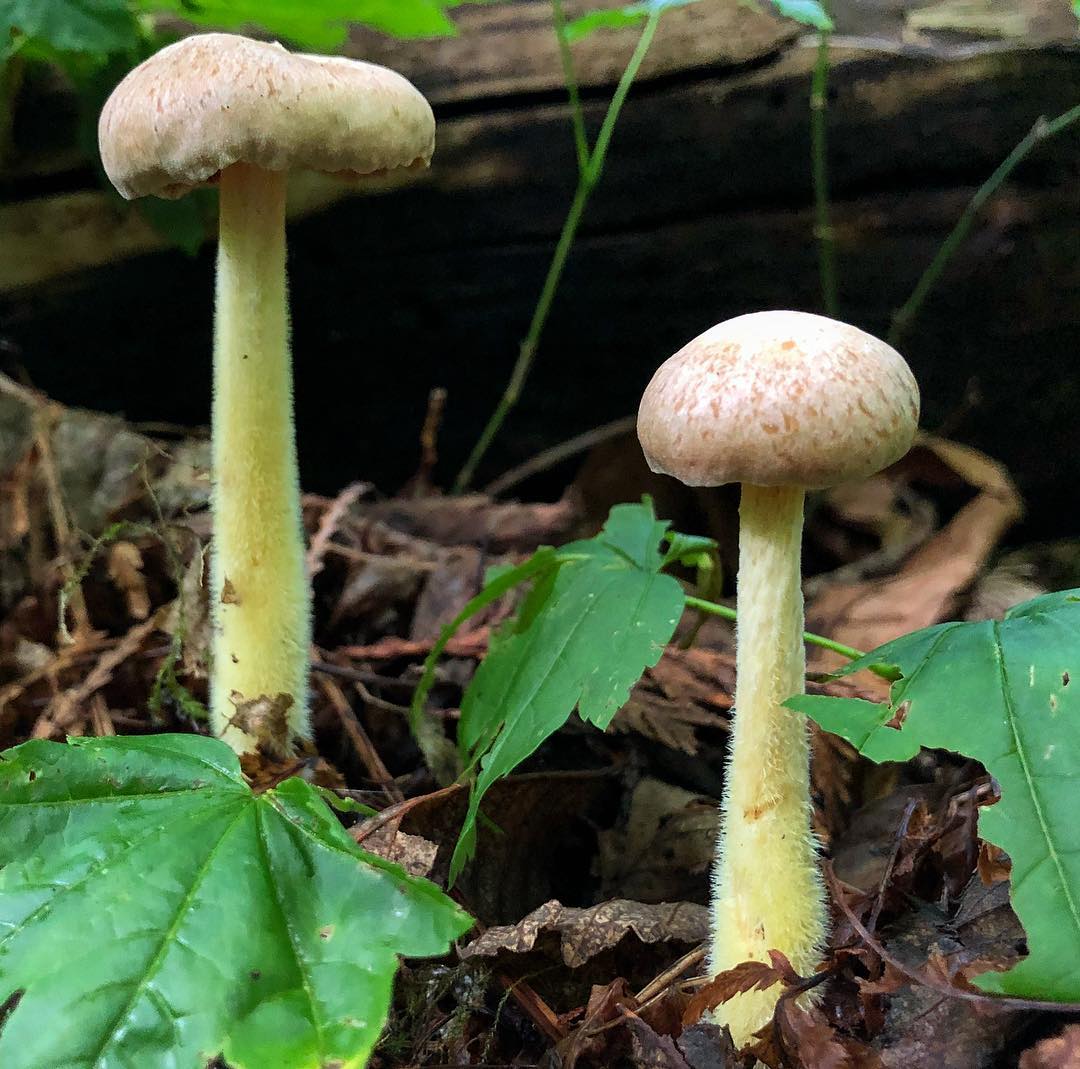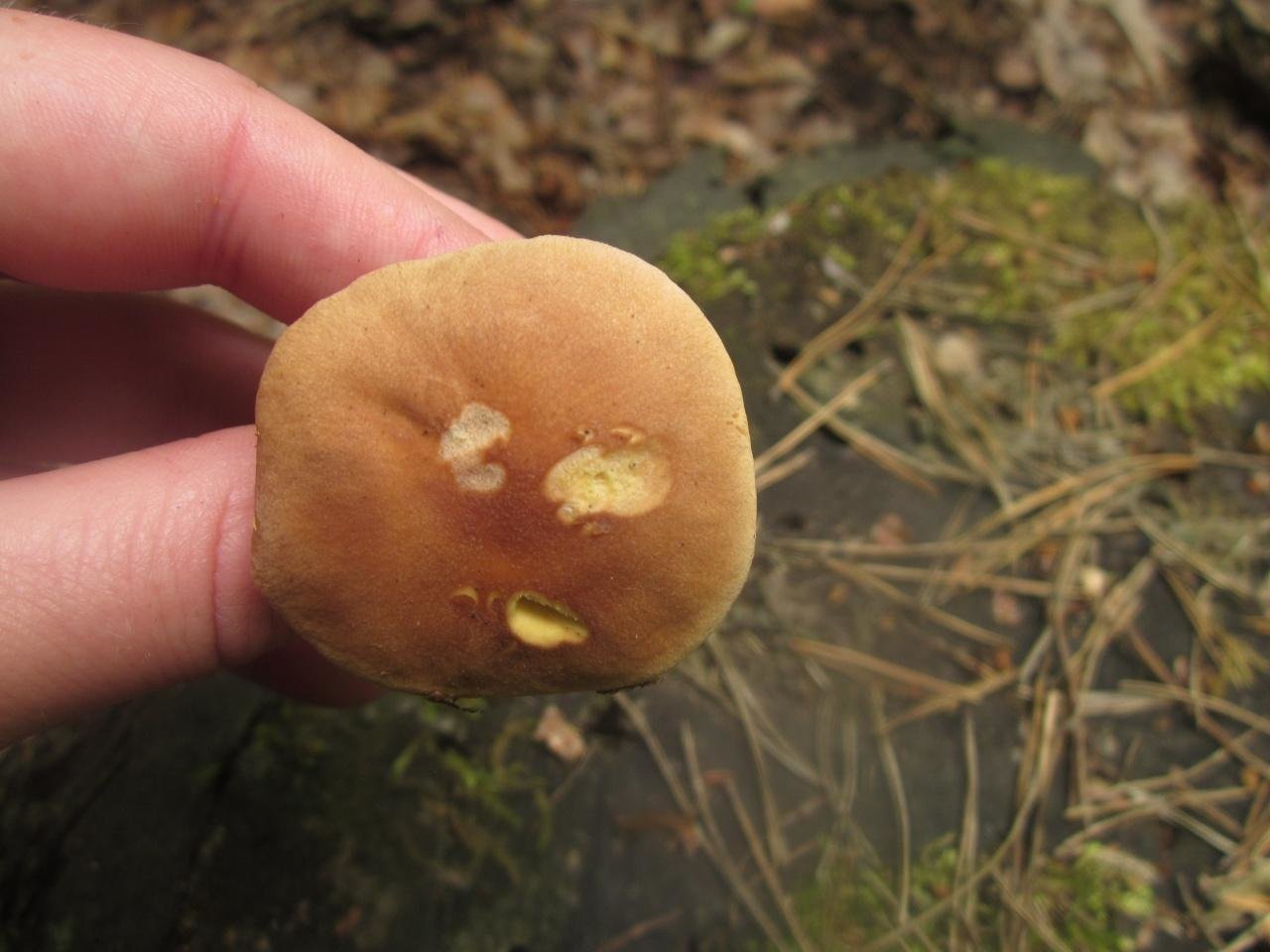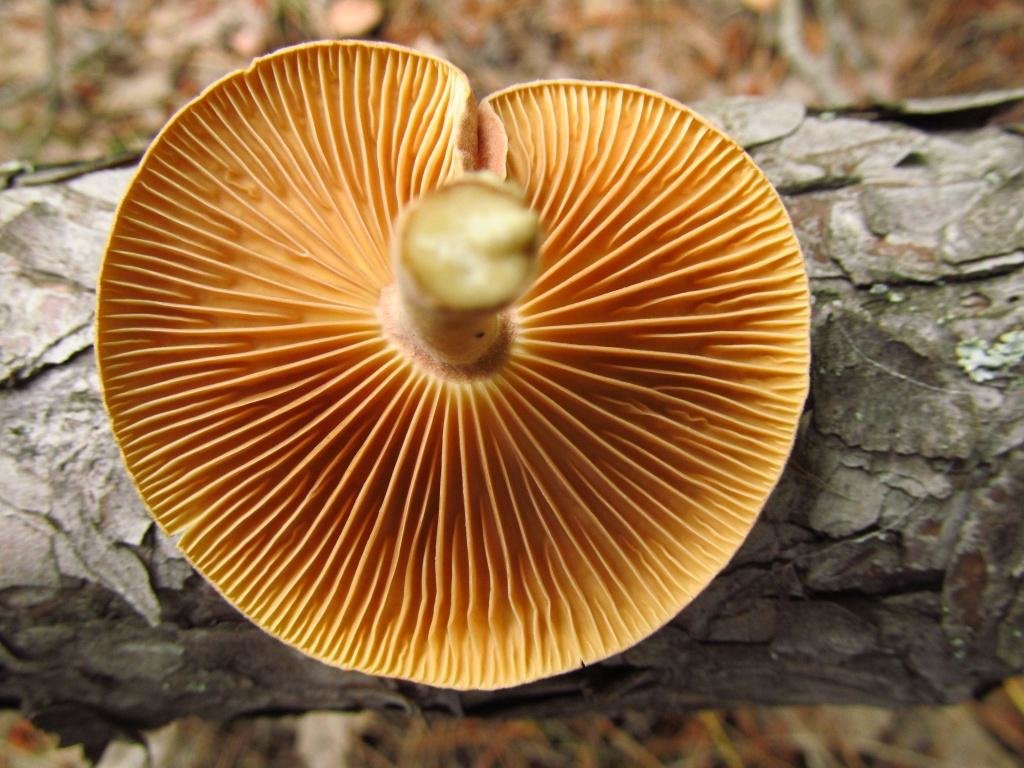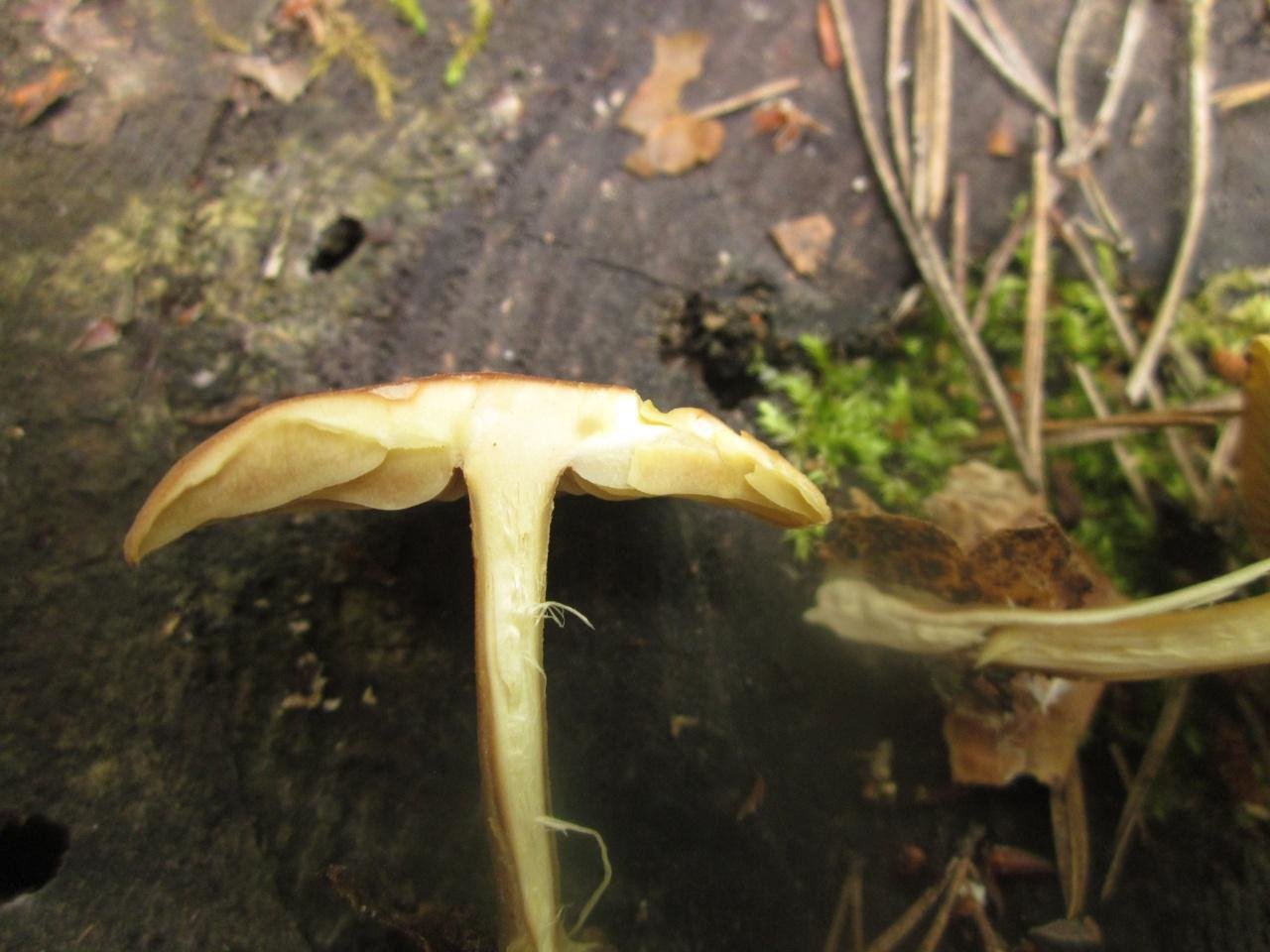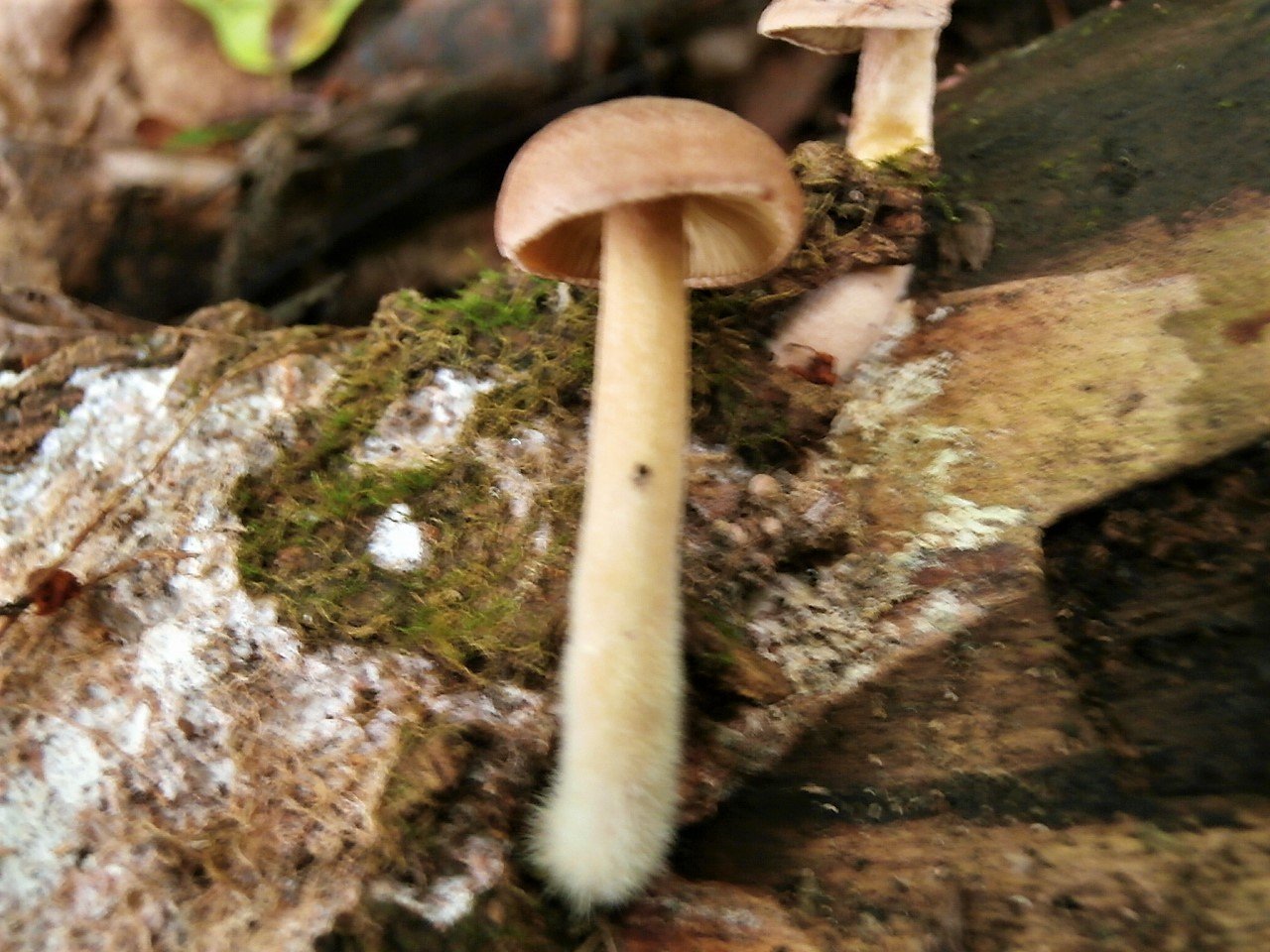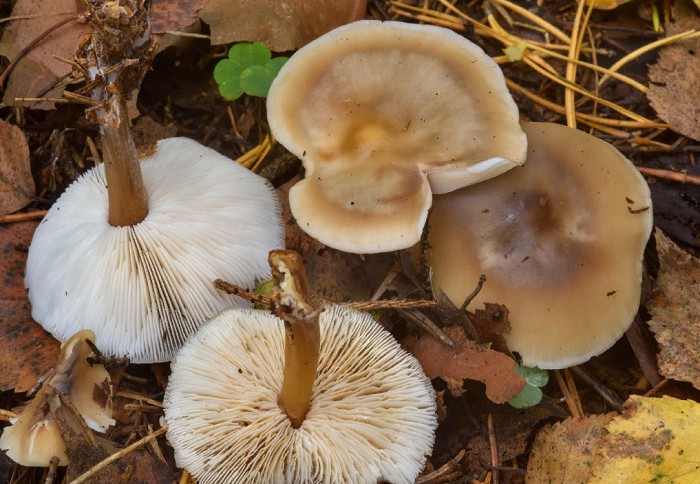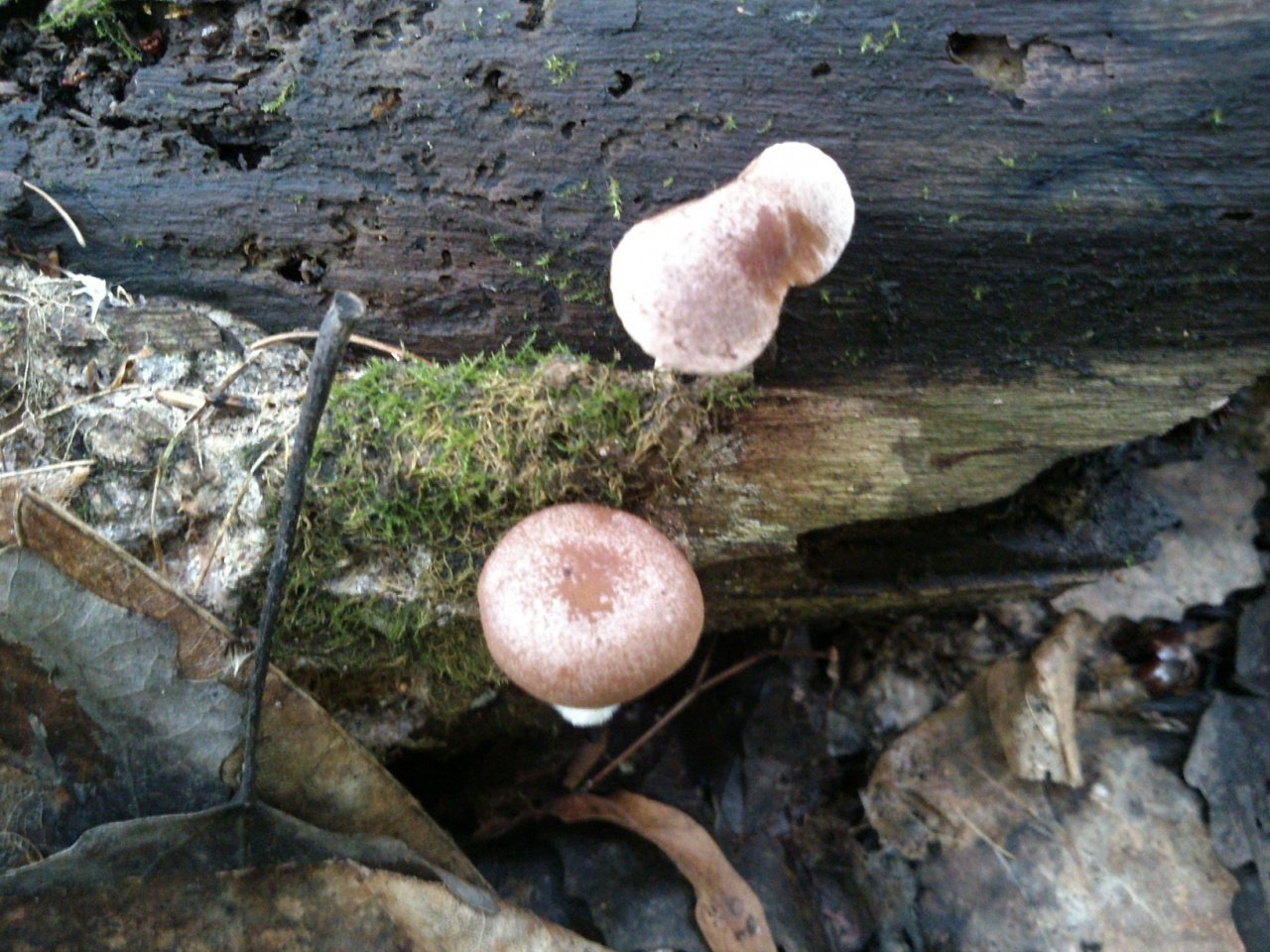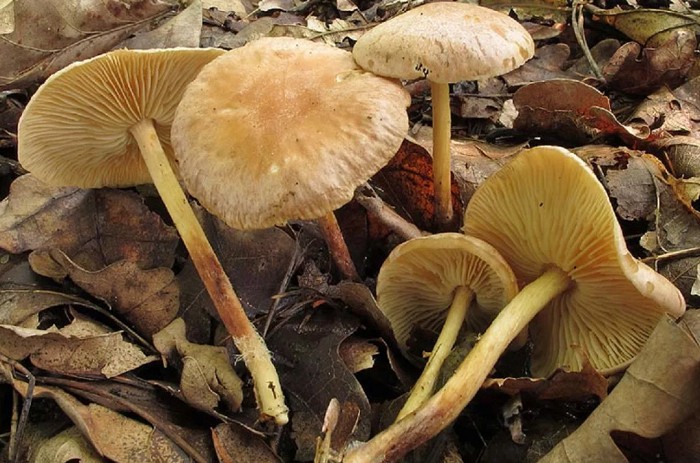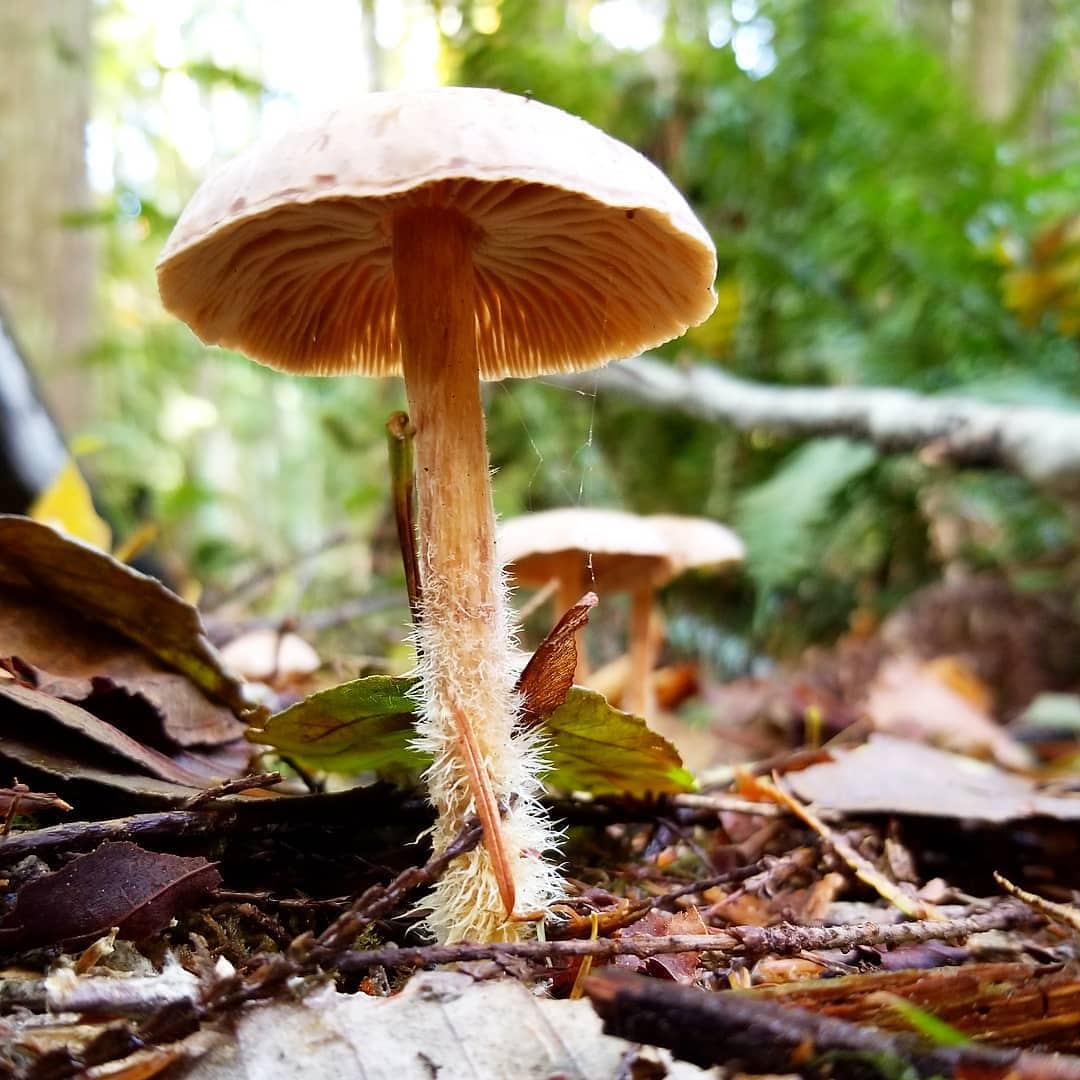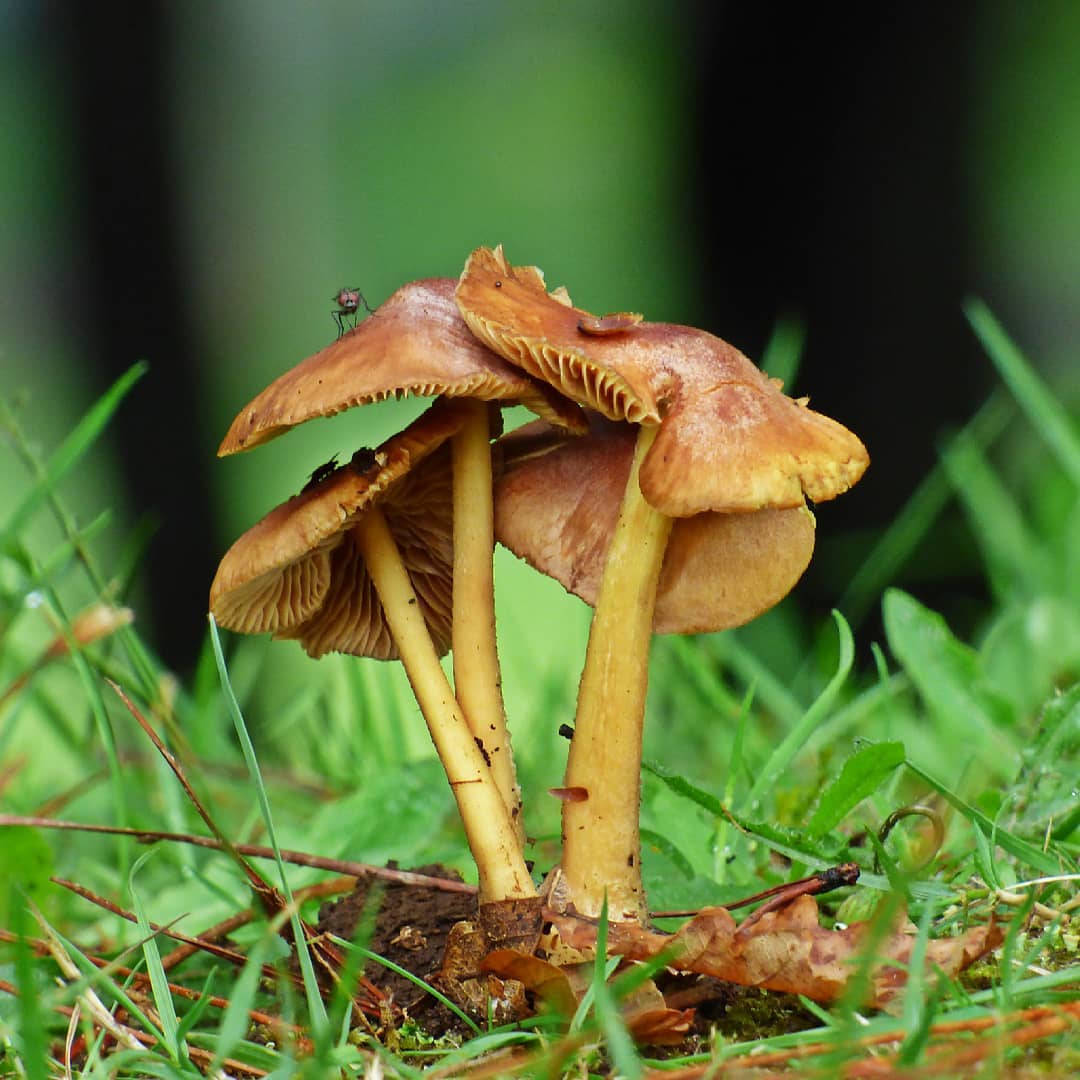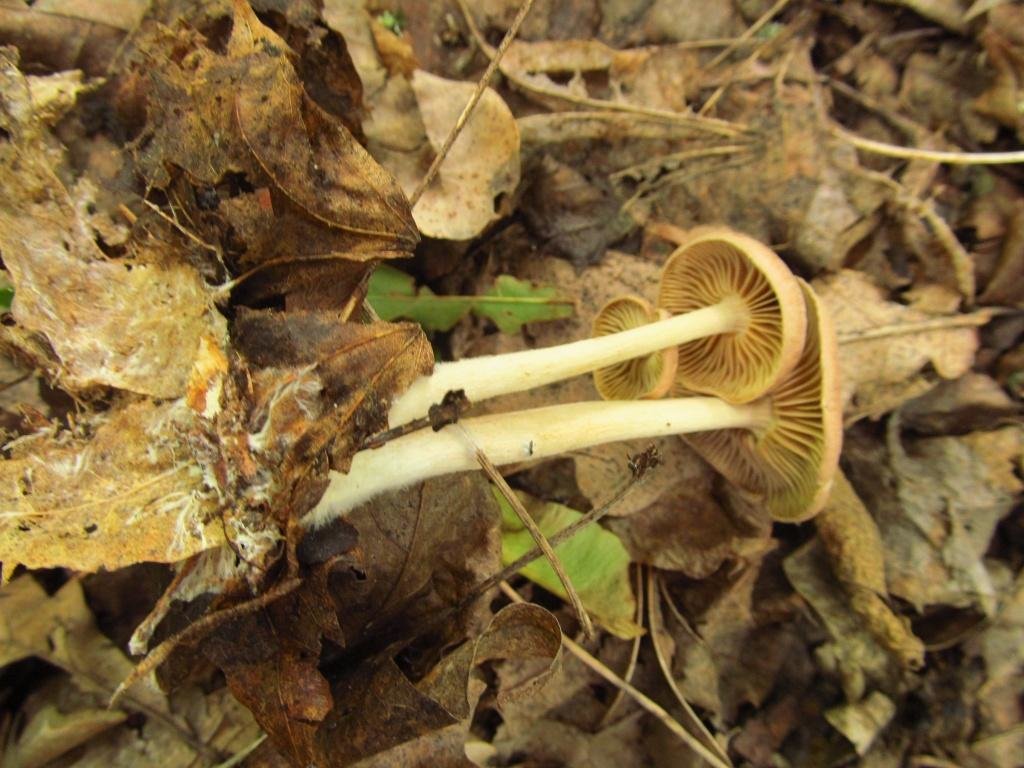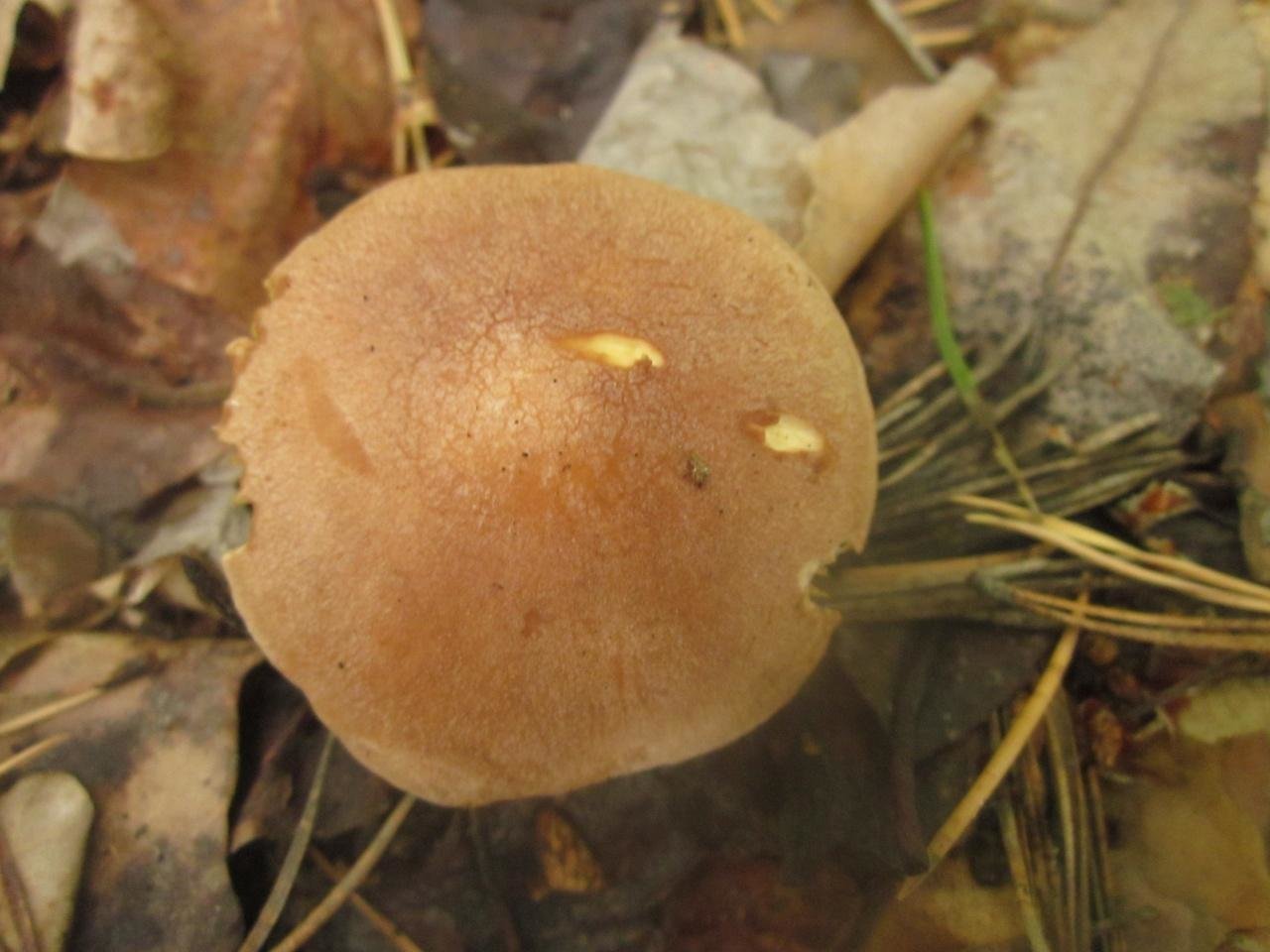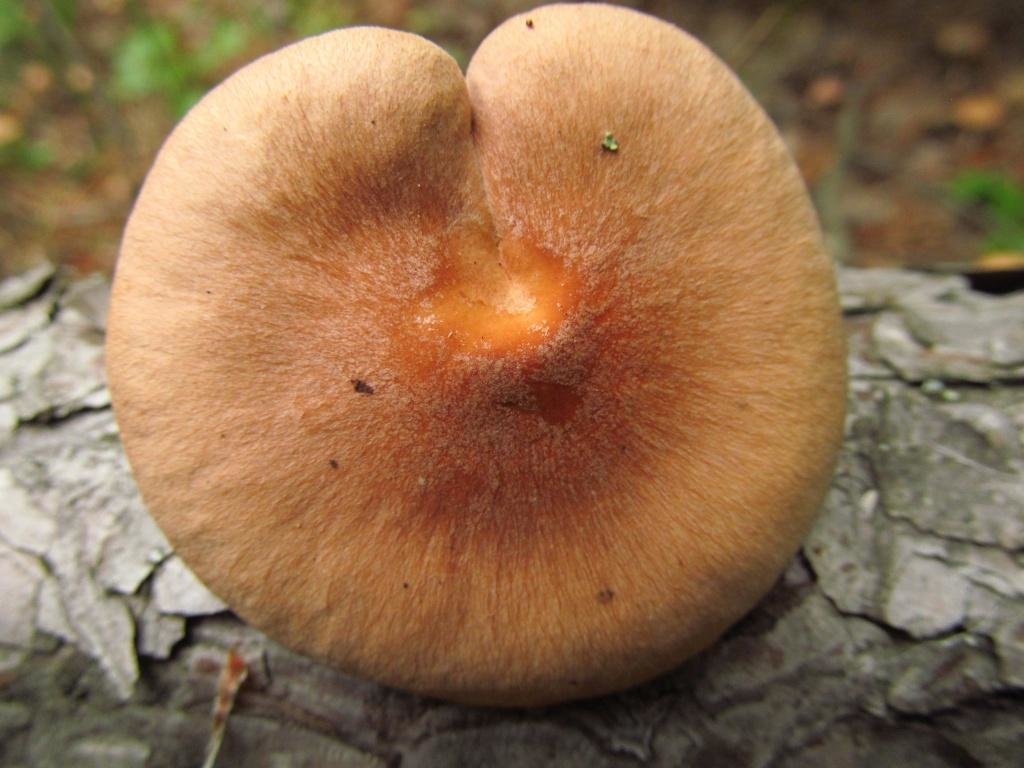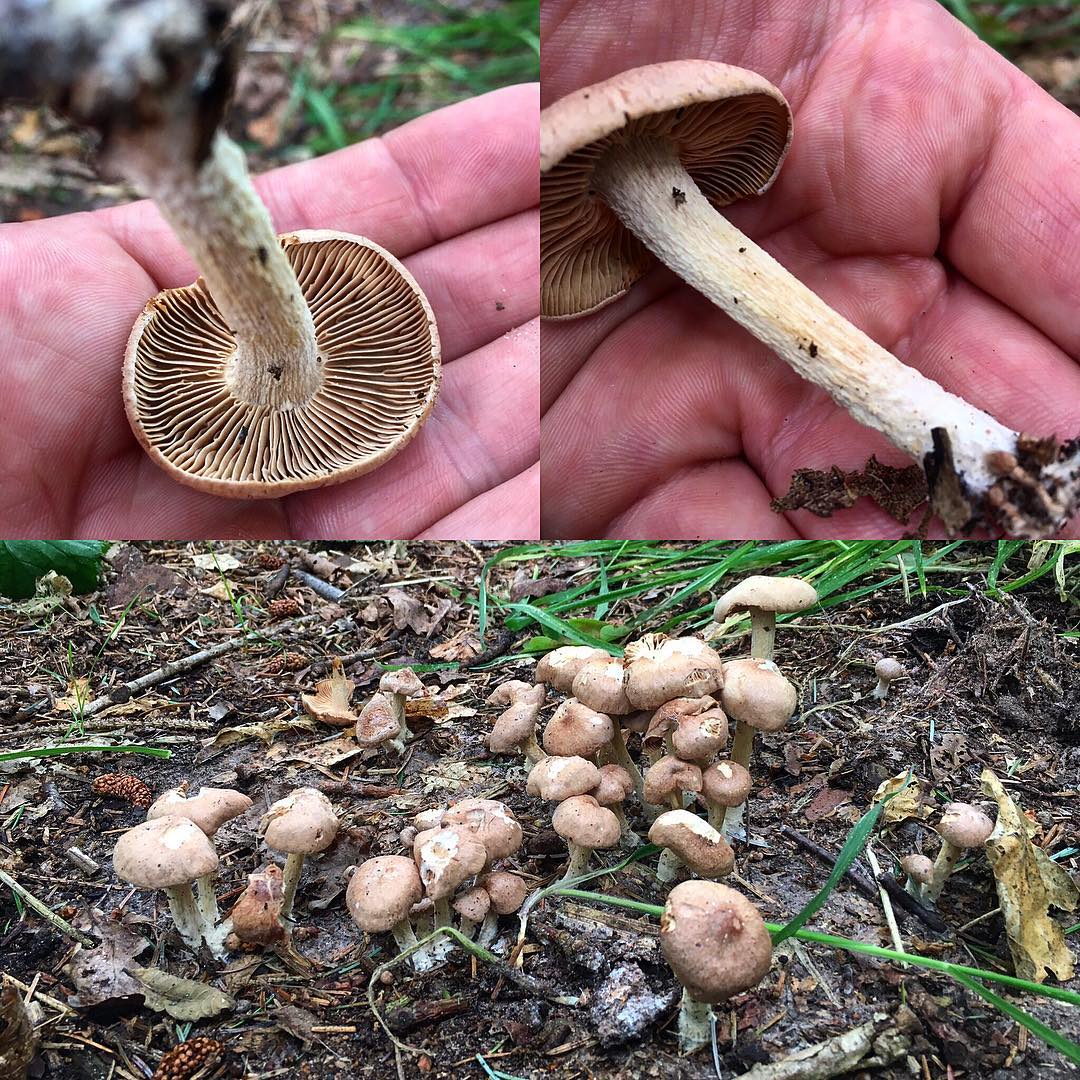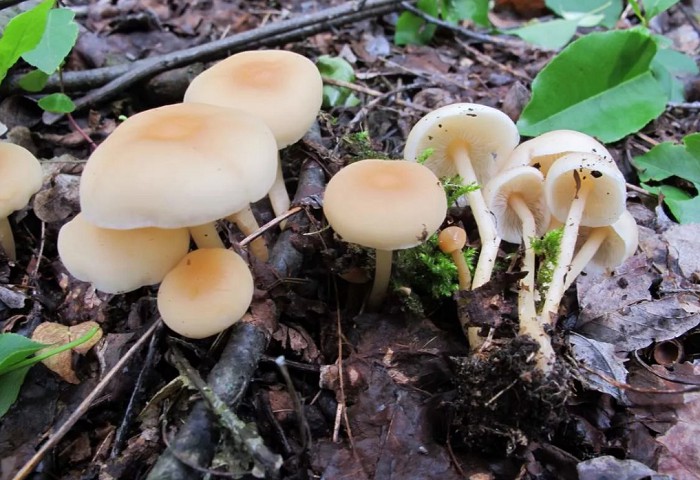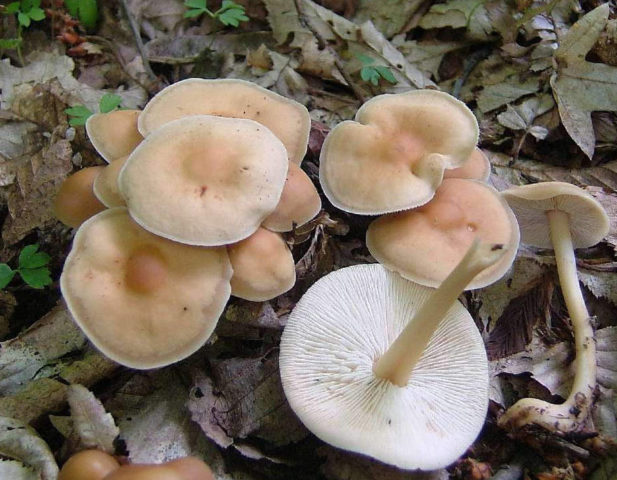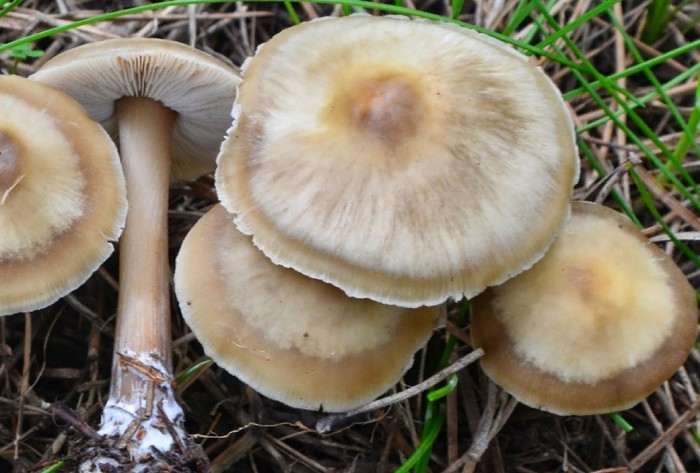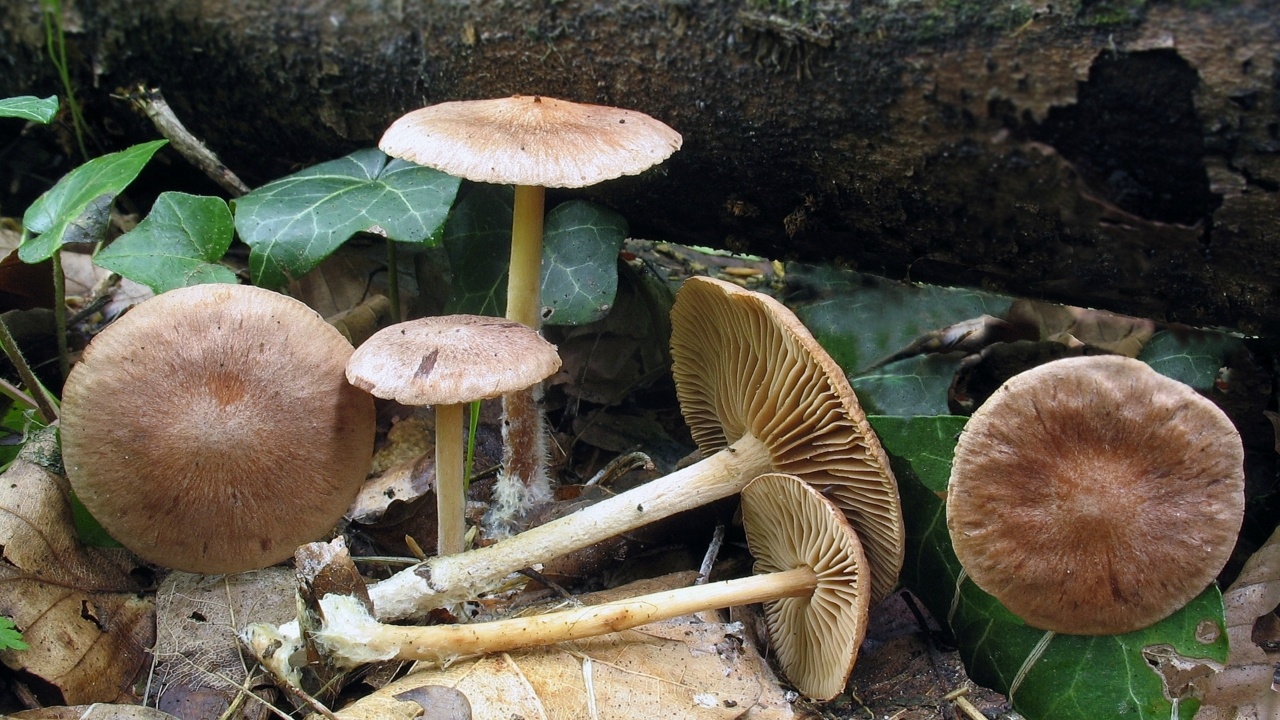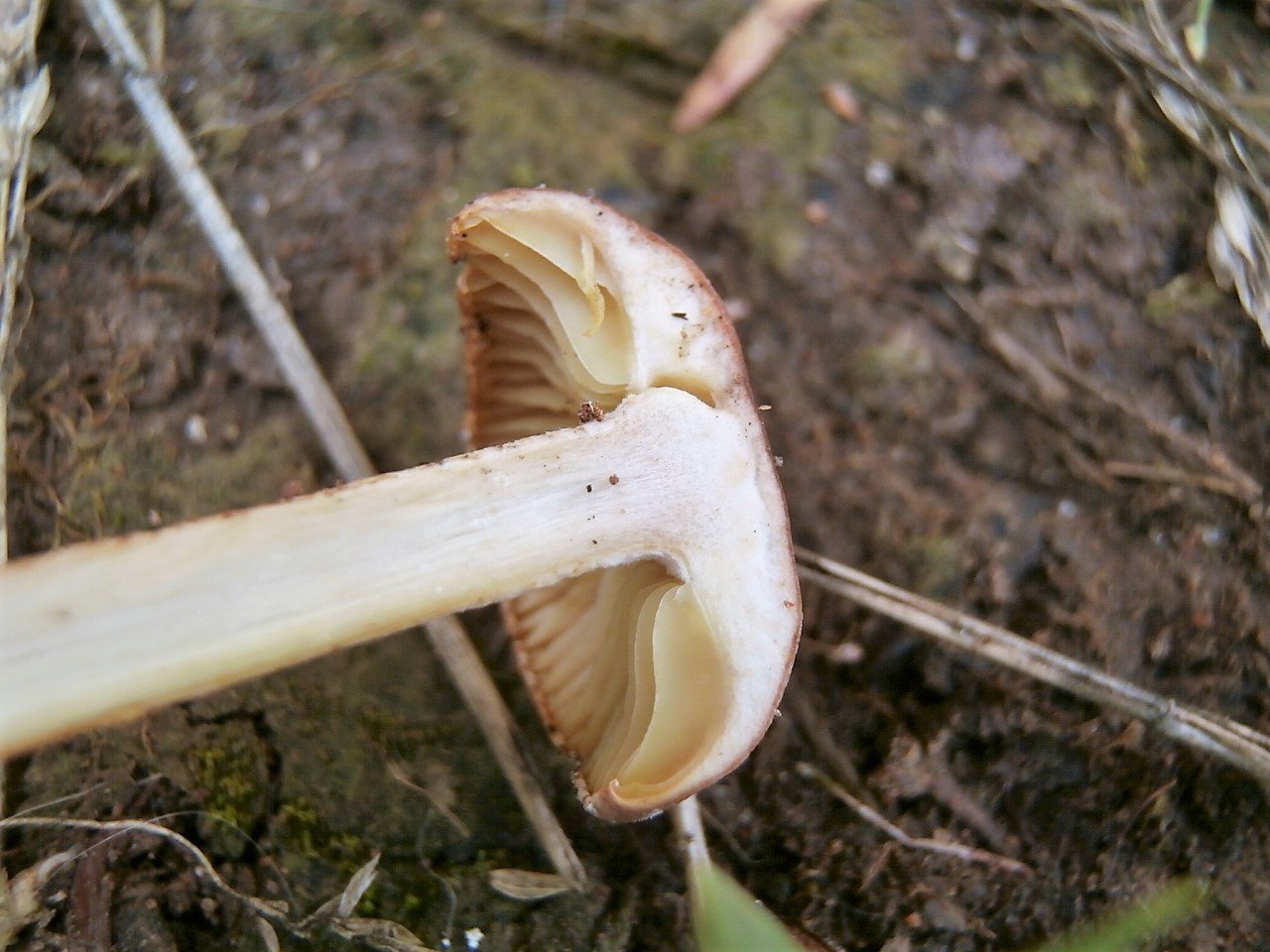Collybia chestnut, or oily (Collybia butyracea)
Habitat: mixed and coniferous forests, on forest floor, on decaying wood, usually grows in groups.
SEASON: May - October.
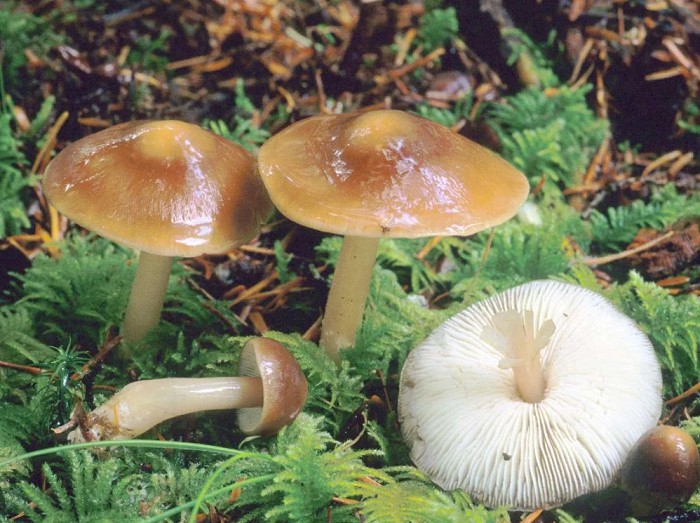
In the middle and end of May, the first types of collibies appear. These include, first of all, chestnut or oily colibs. These cute little mushrooms attract with their spectacular appearance, although they are small in size. Although they are edible, they are not harvested due to their small size and the lowest, fourth category for food properties.
At this time, many singing birds can be observed in the forest, for example, buntings, which climb onto the upper branches and sing, sing, sing.
The cap has a diameter of 3-8 cm, at first hemispherical, later convex with a round tubercle and then prostrate with a flat tubercle and raised or curved edges. A distinctive feature of the species is the chestnut brown color of the cap with a flat tubercle of a darker brown color and light, cream or light brown edges.
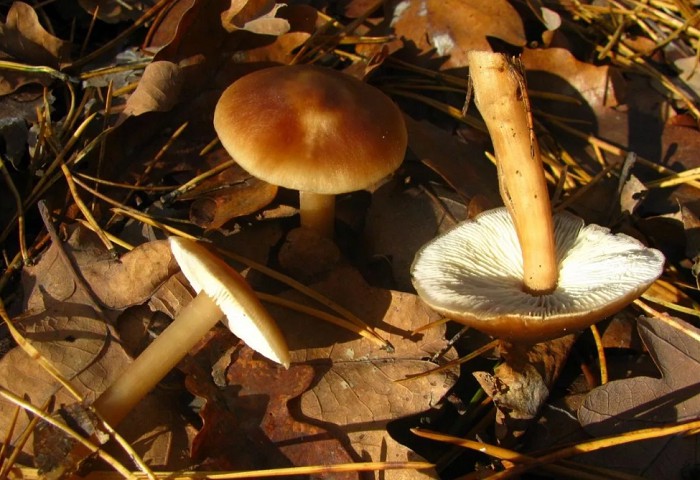
Stem 4-9 cm tall, thin, 2-8 mm thick, cylindrical, smooth, creamy at first, later fawn-brown. The base of the leg is thickened.
The pulp is watery, thin, soft, whitish or yellowish, odorless at first, later with a faint moldy odor.
The plates are creamy or yellowish, notched-adherent. Short free plates are located between the adherent plates.
Variability: The color of the cap is variable depending on the maturity of the fungus, the month and the humidity of the season. The color can be chestnut brown, especially in early summer, red-brown with a brown tint, brown-brown with a dark middle, gray-brown with an olive tint, lilac brown. In the dry season, the cap fades to light shades of yellow, cream and light brown.

Similar species. Collybia chestnut in shape and size is similar to the edible wood-loving collybia (Collybia dryophila), which differs in that it has a much lighter cap.
Edible: edible, but requires pre-cooking in 2 waters to eliminate mold odor.
Edible, 4th category.
Double Colibia shod and their differences
This specimen, like all the inhabitants of the forest, has similar twins. These include:
- Spindle-footed is a conditionally edible mushroom. The cap is relatively large, up to 7 cm in size. The surface is slimy, yellow or light coffee in color. Grows in small groups on dry fallen wood or deciduous substrate, bears fruit from June until the first frost. In cooking, the species is used after soaking and long boiling.
- Azema is an edible species with a flat or slightly curved cap, light coffee in color. Grows among conifers and deciduous trees on acidic fertile soil from August to October. The harvested crop is good fried, stewed and canned.
References
- Roger Phillips (1981). The Mushrooms and other fungi of Great Britain and Europe... Book Club Associates. p. 57.
- ^
- ^ Knudsen, H .; Vesterholt, J., eds. (2008). Funga Nordica Agaricoid, boletoid and cyphelloid genera... Copenhagen: Nordsvamp. p. 300. ISBN 978-87-983961-3-0.
- See the WP Collybia page for full details. The most important reference is
- ^
- Marcel Bon (1987). The Mushrooms and Toadstools of Britain and North-Western Europe... Hodder & Stoughton. p. 178. ISBN 0-340-39935-X.
- Courtecuisse, R .; Duhem, B. (2013). Champignons de France et d'Europe (in French). Delachaux et Niestlé. p. 260. ISBN 978-2-603-02038-8. Also available in English.
- Meinhard Moser (1983). Keys to Agarics and Boleti... Translated by Simon Plant. 15a Eccleston Square, London: Roger Phillips. p. 152. ISBN 0-9508486-0-3.
Les-loving colliery (Gymnopus dryophilus)
- Other names for the mushroom:
- Spring honey
- Collybia is dubious
- Colibia Dubravnaya
- Regular money
- Wood-loving money
Synonyms:
Hat:
Diameter 2-6 cm, in youth hemispherical, with age gradually opens up to prostrate; plates often shine through the edges of the cap. The fabric is hygrophilous, the color changes depending on humidity: the color of the central zone varies from brown to light red, the outer zone is lighter (to whitish waxy). The flesh of the cap is thin, whitish; the smell is weak, the taste is difficult to distinguish.
Plates:
Frequent, poorly adherent, thin, white or yellowish.
Spore powder:
White.
Leg:
Hollow, fibrous-cartilaginous, 2-6 cm in height, rather thin (the mushroom, as a rule, looks proportional), often pubescent at the base, with a cylindrical, slightly widening at the bottom; the color of the leg more or less corresponds to the color of the central part of the cap.
Spreading:
Wood-loving collibia grows from mid-May to late autumn in forests of various types - both on the litter and on the decaying remains of trees. In June-July, it is found in large numbers.
Similar species:
The forest-loving Colibia mushroom can be confused with the meadow honey (Marasmius oreades) - much more frequent plates can serve as distinctive signs of colibia; in addition, there are several closely related species of colibia, which are relatively rare and, without a microscope, are completely indistinguishable from Collybia dryophila. Finally, this mushroom strikingly differs from light specimens of chestnut colibia (Rhodocollybia butyracea) by a cylindrical, not very thickened stem.
Edibility:
Various sources agree that the forest-loving Collibia mushroom is, in general, edible, but it makes no sense: there is little meat, there is no taste. However, no one forbids trying.
Notes:
The pseudo-popular name "money", supposedly referring to all small collisions, does not justify itself at all. For mushroom pickers, colibies are a kind of "backdrop" against which mushroom comedies and dramas are played; small colibies are an element of forest decoration, the same as last year's cones and night blindness flowers. What kind of "money" is there if you can't even count them!
However, some mushroom pickers still pay attention to the wood-loving colibia, strangely calling it "forest meadow honey." At the same time, explanations always follow in the sense that it makes no sense to collect forest meadow mushrooms, because there is neither taste nor smell in them
So, something has grown.
Naming
This species was originally described by James Bolton in his 1788 book "An history of fungusses, growing about Halifax" as Agaricus peronatus at a time when all gilled mushrooms were assigned to genus Agaricus... Then in 1821 another Englishman, Samuel Frederick Gray published his “Natural Arrangement of British Plants” (including fungi) in which he allocated the species to the already existing genus Gymnopus.
In 1791 Bulliard described the same species as Agaricus urens, the epithet "urens" ("burning") referring to the acrid taste, and in 1836 Fries put it genus Marasmius... Also in 1871 Paul Kummer put this mushroom in genus Collybia, giving it the name Collybia peronata... For many years it was known either as Marasmius urens or Collybia peronata (or sometimes Marasmius peronatus or Collybia urens). The peronatus and urens forms have been distinguished as different species, urens having a lighter-colored cap, but this view is outdated.
In much later work culminating in 1997, Antonín and Noordeloos found that the genus Collybia as defined at that time was unsatisfactory due to being polyphyletic and they proposed a fundamental rearrangement. They resurrected the genus Gymnopus for some species including peronata, and after subsequent DNA studies, this has been accepted by modern authorities including Species Fungorum and the Global Biodiversity Information Facility, and so its current name has reverted to Gray's combination, Gymnopus peronatus.
The species name peronatus indicates that the stem is "booted" with a hairy covering below (from the Latin peronatus meaning "rough-booted").
Collybia peronatus
Habitat: mixed and coniferous forests, on forest floor, in moss, on rotting wood, stumps and roots, grows in groups.
SEASON: June - October.

The hat has a diameter of 3-6 cm, at first it is hemispherical or convex with a curved edge, then convex-outstretched with a small flat tubercle, matte in dry weather. The first distinctive feature of the species is the creamy pink color of the cap, with a darker pinkish-red zone in the middle and a brownish edge with fine fringes or teeth.
Leg 3-7 cm high, 3-6 mm thick, cylindrical, widened near the base, hollow inside, of the same color as the cap or lighter, with a felt coating. The second distinctive feature of the species is the special structure of the leg. It contains two parts - the upper hollow light brown and the lower one - wider and dark brown, which is like a shoe for the leg. These parts may or may not be separated by a thin light strip.
The pulp is thin, dense, yellowish, without a special smell, but with a burning taste.
The plates are of medium frequency, weakly adherent or loose, narrow, frequent, then reddish, pink-brown, yellow-brown with a lilac tint.
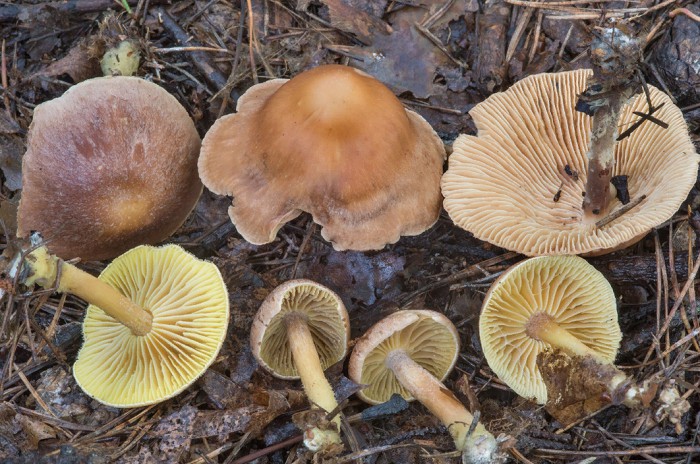
Variability: the color of the cap is variable depending on the maturity of the mushroom, the month and the humidity of the season - gray-brown, pinkish-brown, pinkish-red with a darker, usually brown middle. The edges may be slightly lighter and have a small fringe, but there may be other, pinkish-brownish color and also with a fringe, similar to teeth.
Similar species. The view is very characteristic and easily distinguishable from others.
Inedible due to pungent and pungent taste.
| Name: | Collibia wrapped |
| Latin name: | Gymnopus peronatus |
| Type of: | Inedible |
| Synonyms: | Shod anthem, Collybia peronata, Shoe money |
| Specifications: |
|
| Systematics: |
|
Wrapped collibia is an inedible mushroom of the Omphalotoceae family. The species grows in mixed forests on humus or fine dry wood. In order not to harm your health, you need to have an idea of the appearance, view photos and videos.
Collibia merging (money merging, Gymnopusconfluens) what mushrooms look like, where and how they grow
Merging money (merging collibia): photo and description
| Name: | The money is merging |
| Latin name: | Gymnopus confluens |
| View: | Inedible |
| Synonyms: | Collybia confluent, Collybia confluens |
| Specifications: |
|
| Systematics: |
|
Often mushroom pickers meet on their way whole meadows of long-legged bell-shaped mushrooms. Collibia confluent often grows on stumps in groups of 2-9 or more specimens
Mushroom pickers who do not have much experience often mistake them for mushrooms, but in order not to miscalculate when collecting, it is important to know the varietal characteristics and view the photo
How does collibia look like merging
Fusion colliery, or fusion money, belongs to the inedible species. So, in order not to harm your own body, you must be able to recognize mushroom species by their external properties.

Description of the hat
At a young age, the mushroom has a hemispherical cap with a diameter of 20 mm. As they grow older, the cap grows in size, acquires the shape of a bell with a pronounced tubercle in the very center. The glossy surface is smooth and thin, through which the lamellar bottom can be easily seen. The skin is covered with light brown paint. The edges are very light and wavy. With age, the color lightens to a fawn or cream color.
On the inner side, adherent or partially adherent countless narrow plates of a whitish or yellowish color are located.
Like all representatives of the mushroom kingdom, Colibia confluent reproduces by long spores located in a spore powder.
Leg description
The longitudinally folded cylindrical leg can reach a height of 100 mm and a thickness of 5 mm. The pulp is tough and fibrous, covered with paint in a white-yellow color, which changes with age to rusty-red or red-brown.
Eat a mushroom or not
Regardless of the fact that the pulp is dominated by a pleasant taste, the mushroom is considered inedible, as it exudes a fetid smell of rotten cabbage.
Where and how it grows
This species can be found in large families in mixed deciduous forests, on rocky areas, in fallen leaves, on stumps and in dust. Fruiting comes from mid-July and lasts until the first frost.
Doubles and their differences
Collibia confluent has edible, toxic and conditionally edible counterparts.
- Colibia buttered - the edible variety has a red-brown leg and a cap of the same color up to 120 mm in size. The surface is smooth, after the rain has passed, it becomes covered with mucus. The species has a tough pulp, grows in coniferous forests.
- Mycena oblique is an edible species that has a thin bell-shaped head. It prefers to grow on stumps in an oak grove.
- Collibia spotted is a conditionally edible species. The fused white cap is covered with separate reddish specks. Grows in deciduous and coniferous loess.
- Wrapped collibia is an inedible variety with a brown-red cap. The surface is smooth, during drought it acquires a golden color.
- Colibia tuberous is a dangerous species. Mushrooms are small in size, cream colored. May cause food poisoning if eaten.
Conclusion
Collibia merging due to tough pulp and unpleasant aroma is considered an inedible species. Thus, in order to protect yourself, it is worth looking at the photo and getting acquainted with the varietal parameters.Skilled mushroom pickers recommend passing by an unfamiliar specimen, as often confusion occurs and toxic species enter the basket.
Description
The following sections use the given references throughout.
General
Yellowish specimens
- The cap grows from about 2 cm to 6 cm, and is yellowish or reddish brown.
- There is no ring or other veil remnant. The stem is roughly the same color as the cap and up to about 8 cm long and only 0.5 cm in diameter. It is typically pruinose ("frosted") above and strigose (hairy) near the base.
- The well-spaced gills are concolorous with the cap or somewhat lighter.
- The undamaged mushroom has little smell, but on bruising it has an aroma of vinegar. The taste is acrid or peppery.
Distribution, habitat & ecology
This saprobic mushroom grows generally in smaller or larger clumps on leaves or needles in deciduous or coniferous woods and may be found from May to December.
It is common throughout Europe, and has also been reported from a few sites in America and Japan.
Description of the wrapped collibia
Wrapped collibia or shod money is a fragile, miniature specimen that grows in regions with a temperate climate. Since the mushroom is inedible, you need to know the detailed description so as not to get an upset stomach.

Description of the hat
The hat is small, up to 60 mm in diameter. In young specimens, it is bell-shaped; as it grows, it straightens, keeping a small mound in the center. The surface is covered with a thin matte skin with pronounced whitish spots. In dry weather, the mushroom is colored light coffee or cream. When it rains, the hue changes to dark brown or ocher. The pulp is dense, brown-lemon.
The spore layer is covered with thin long plates that partially grow to the peduncle. In adolescence, they are canary-colored; as they grow older, the color changes to red or light brown.
Reproduction occurs with transparent oblong spores, which are in a pale yellow spore powder.
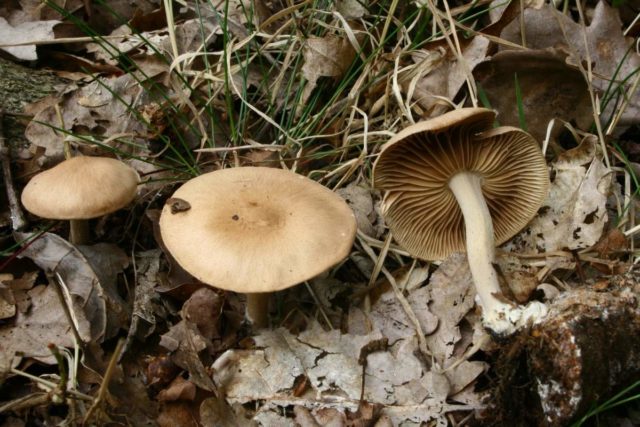
Leg description
Elongated leg, extending to the bottom, up to 70 mm long. The skin is smooth, fibrous, canary-gray in color, covered with a lemon felt bloom. The lower part is whitish, covered with mycelium. There is no ring at the base.
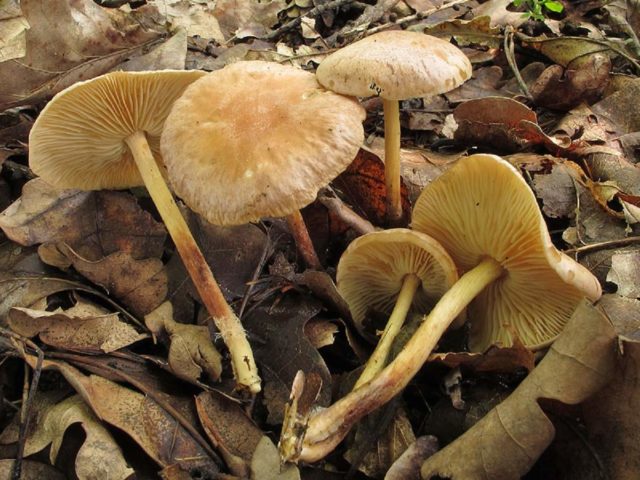
Colibia chestnut
Collybia chestnut - Collybia butyracea
In another way, the mushroom is called Oil Colibia, Chestnut Rhodocolibia, Oily Colibia, Oily Rhodocolibia, Oil Money, Oil Gymnopus, Chestnut Gymnopus or Chestnut Money.
Description
Mushroom cap
Colibia oily has a large hat reaching 80-120 mm in diameter. In adolescence, the caps are hemispherical, later spread, but remain convex, or open so that their edges rise. The edge, usually wavy, cracks with age. A flat mound remains in the middle of the hats.
"Hats" are covered with a shiny, oily smooth skin, moist in damp weather and dry in fine weather. Depending on weather conditions, they are painted in different colors: reddish-brown, chestnut, dark brown, chocolate, brown-olive, yellow-brown. The damp the weather, the darker the hat. The mounds are usually darker, the edges are light: their color ranges from cream to pale brown.
Mature Denezhka chestnut becomes darker, especially the tubercles, which become dark brown or brown-black.
The hats are filled with thin, watery soft flesh of a white or yellowish hue.
Hat bottoms are covered with many frequent loose wide plates with an uneven scalloped edge - both long and short. Young Gymnopus chestnut has white plates, mature ones - grayish.
Collibia chestnut reproduces by whitish elongated spores that ripen in pale pink or white spore powder.
Stipe
Rhodocolibia oily builds up an even cylindrical leg, widening downward, tapering upward, and reaching 4-10 mm in thickness and 20-100 mm in height.
The legs are not filled with pulp and consist of hard fibers; at the base they are pubescent with white mycelium. They are painted in a chestnut or brown tone, gradually darkening as they approach the bottom.
Collybia chestnut - Collybia butyracea
Growing places
Oily money prefers conifers and mixed forests with conifers and acidic soil. Fruiting is rarely solitary, usually the mushroom grows in whole families.
Depending on climatic conditions, it falls in May - November, until severe frosts come, making the mushroom sluggish and lifeless.
Edibility
The pulp of Rhocollibia chestnut has a watery structure and has a very weak smell of mold, which is why the mushroom is classified as conditionally edible mushroom of the 4th category. Only hats of reddish and brownish-red tones can be eaten, since after boiling their flesh loses its moldy smell.
The oily hymnopus can be stewed, fried, salted and marinated after 20 minutes of boiling. You can dry it without boiling it first, but later, before using it for culinary purposes, you first need to boil the mushrooms and drain the broth.
Description
The main
The fruiting bodies of curly colibacillus usually appear in large clusters on decaying mushrooms.
The cap is convex at the beginning with age, becomes flat or slightly concave in the center, reaching a diameter of 3-11 mm. The edge of the cap is first tucked or bent inward, but then straightened. The surface of the cap is dry or damp, it can be smooth or covered with fine whitish hairs, with translucent grooves along the edges of the cap. The hat is almost hygrophilous (changes color depending on humidity): usually white or slightly pinkish, when wet or old it turns grayish-orange.
The flesh is whitish, very thin, without a distinct taste or smell.
adherent with a tooth, slightly arcuate. The number of plates is from 12 to 20; in addition, there are short plates. The blades are thin, frequent or moderately sparse, from white to pinkish brown. The edge of the plates is colored in the same way as the entire plate.
The leg is 8-25 mm long and up to 2 mm in diameter, even or slightly thickening downwards, flexible, fibrous, not brittle; becomes hollow with age. The surface of the peduncle is dry, from whitish to grayish-orange, sometimes with fine hairs in the upper part of the pedicle, which become coarser towards the base. The base of the peduncle often bears root-like filaments or is covered with whitish mycelial felt. Unlike other species of the genus, it does not form sclerotia at the base of the peduncle.
Microscopic signs
The spore powder is white. Spores 4.8-6.4 × 2-2.8 (up to 3.5) µm, ovoid or ellipsoid, drop-shaped when viewed from the side. Smooth, non-amyloid, acyanophilic (does not react with methyl blue).
Basidia (cells bearing spores located on the plates) are almost clavate, 4 spore-like, 17.5–21 × 4.8–5.6 µm. Cystidia are absent.
The plates consist of intertwining more or less parallel smooth non-amyloid hyphae, 2.8–8.4 µm in diameter. In the pulp, the caps above the plates of the hyphae are radially oriented; they are also not amyloid, 3.5–8.4 µm in diameter, smooth, but with unevenly thickened walls.
The cap cuticle consists of a gelatinized layer of hyphae, which lie parallel to the cap surface. The hyphae forming this layer are 2.8–6.4 µm in diameter, smooth, thin-walled. They are covered with scattered short saccular outgrowths. The surface of the peduncle consists of a layer of parallel, vertically oriented hyphae 3.5–4.2 µm in diameter, smooth, slightly thick-walled, becoming pale yellowish-brown in alkali solution. Caulocystids with many septa 2.8–4.8 µm in diameter, smooth, thin-walled, almost cylindrical. Buckles are found in all fabrics.
Similar species
Collybia cirrhata can be confused with other species of the genus Collybiawhich have a similar appearance and ecology. Collybia tuberosa characterized by the presence of a dark reddish-brown sclerotia, similar to apple seed. Collybia cookei has wrinkled, often irregularly shaped sclerotia of pale yellow or orange color. Other similar species, including Baeospora myosura and species of the genus Strobilurusgrowing on pine cones.

